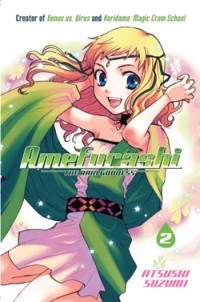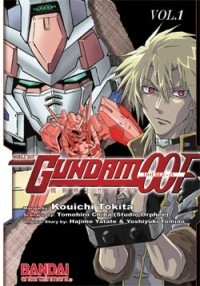RIGHT TURN ONLY!!
Three-For-One Piece
by Carlo Santos,

It's amazing to think that it was around this time 10 years ago (plus a couple of months) that I first "got into anime." Ten years! The idea that you could watch videos on a computer was crazy talk back then! And yet, there were still plenty of websites and other resources on how to get into anime.
Funny thing is, they never tell you how to get out.
ALIVE: THE FINAL EVOLUTION

Vol. 8
(by Tadashi Kawashima and Adachitoka, Del Rey, $11.99)
FROM THE BACK COVER:
"Taisuke has always used hs amazing gifts for the forces of good. But now he's crossed over to the dark side—to a hidden half of his personality that grants him extraordinarypower. Will Taisuke given in to this seductive new evil?"
EVIDENCE FOR:
Alive may be deep in the throes of climactic battle, but it still has the capacity to surprise, as proven by Taisuke's discovery of his inner bad boy. His sudden power surge, however, is nothing compared to the emotional transformation that comes about one chapter later: a horrific tragedy happens right before his eyes, and he lets out this bloodcurdling scream—a scream so powerful that it seems to shake the very pages of the book. Firefights and fistfights are nice, but when the stuff starts getting into your head ... that's when the drama really happens. And that's also why Nami vs. Kanon (ice vs. explosions) is the single most thrilling battle throughout this volume—because each combatant has a deep, personal motivation for wanting to fight. Of course, these battles wouldn't be half as thrilling without Adachitoka's command of pen and paper; every action scene is a ballet of slick moves and precise layouts that flow from one moment to the next. Taisuke's upgraded abilities are especially impressive to watch, almost as if someone had rendered a martial arts movie clip in slow motion—and it looks like there's plenty more to come.
EVIDENCE AGAINST:
You know, Alive was really not that bad when it was following a straight, predictable path where these kids were road-tripping across Japan and running into various opponents with psychic powers. Now that they're all gathered in one place for the Big Fat Final Battle ... it's become a mess. The constant switching between different scenarios—sometimes just 50 feet away from each other!—is a pain to keep up with, and let's face it, only about 20% of the characters are interesting to watch. Everyone else is just standing around, battling at reduced strength, or their powers are kind of lame, and this volume doesn't become good until about halfway when Taisuke lets out that scream and the plot finally turns the corner. Even then, now that the central mystery has been all but revealed, it turns out to be a pretty shallow story after all: crazy bad guy plans to take over the world, gathers up a bunch of psychic-powered people in order to do it. That's all it really was, no amazing twist or conspiracy waiting in the wings. Unless it happens later. But it clearly doesn't happen here.
FINAL VERDICT:
Another 200 pages of battle (with occasional plot developments)? Isn't that what happened last time, too? Slick action scenes win this one a C+ but it's going to really have to pick up on storyline.
AMEFURASHI: THE RAIN GODDESS

Vol. 2
(by Atsushi Suzumi, Del Rey, $10.99)
FROM THE BACK COVER:
"Gimmy has never met a girl like Sora. She's a gorgeous and glamorous teen diva—who also happens to be an amefurashi, a rain goddess who brings life-giving water to Gimmy's desert village. But as Gimmy is about to discover, Sora is also a regular girl at heart—one who can laugh, cry, and maybe even fall in love!"
EVIDENCE FOR:
What do you do when you find out your manga series is getting canned? Figure out how to end it quickly! This actually works in Amefurashi's favor, with Volume 2 showing a much more purposeful direction than the first as it barrels toward an abrupt yet satisfying conclusion. It's got all the earmarks of a classic fantasy adventure: trekking through exotic locales, facing one's destiny, and dispatching the big bad boss at the end in a grand display of sorcery. Atsushi Suzumi's sure-handedness with a pen makes it work, as broad desert landscapes provide the setting for Sora's quest to regain her goddess powers, while fantastical imagery such as a tower made of clouds and a giant enchanted tree provide the necessary visual flair. The characters, too, are eye-catching in their own way, whether it be Gimmy's trademark glasses or the flashy outfits of Sora and the other amefurashi. Best of all, the series finds its heart and soul at just the right moment, with Gimmy and Sora's friendship proving to be the catalyst that—with a little magical hand-waving—saves the world. And that's a pretty good place to stop.
EVIDENCE AGAINST:
Yes, it's something of a miracle that this series was able to finish up in two volumes without using the "Our adventure is just beginning!" escape route. But instead, the path it takes is one littered with pre-fabricated scenarios, cut and pasted together when you're too lazy to tell a real story. Just look at how 60% of this volume is a checklist of sub-quests: go here, do this, then go here, and do some other thing, which in a longer series could be extended indefinitely. Then comes the final battle, which itself is pieced together from overly familiar situations such as "villain tries to combine multiple magical powers in a really evil way" and "heroine is taken over by dark magic at the last moment." So, yes, it's a satisifying fantasy ending, but only because it's borrowed from everything else. The real transgression, however, is trying to pull off that kind of ending in a short series—it just doesn't work when there hasn't been time to develop the characters, the plot, or the world they live in. And so this tale of a rain goddess peters out as a light, ineffectual drizzle.
FINAL VERDICT:
It could have been better, but for a short series, it could also have been worse. If you're not going to do anything original, at least do it well, and this one does it well enough to earn a B-.
GUNDAM 00F

Vol. 1
(by Kouichi Tokita and Tomohiro Chiba, original concept by Hajime Yatate and Yoshiyuki Tomino, Bandai, $10.99)
FROM THE BACK COVER:
"The year is 2307 ... and the world is not a united one. A private organization calling themselves 'Celestial Being' rises up to intervene, with the expressed goal of ending all wars on Earth using the Mobile Weapon Gundam. There's another organization operating in its shadow, too, discreetly giving them support: Fereshte. Telling the tale of Fereshte's Gundam Meister, Fon Spaak, the official side-story of Mobile Suit Gundam 00 starts here!"
EVIDENCE FOR:
In a way, this Gundam 00 spinoff is more interesting than the original. And that's because the main character is one crazy guy! More than stirring space battles or heated geopolitics, the sheer lunacy of Fon Spaak is the driving force behind this series—and a lot of times it works. His disregard for authority sparks many of the personal and philosophical conflicts in this story, while his battle prowess makes the action scenes what they are, and there is nothing quite as electric as seeing him cackle, "Agyagyagyagyaaaaah!" At the same time, though, this volume is still able to weave in the main events of the original, providing a stable framework for the series instead of just having a daffy Gundam Meister running around making trouble. At one point, however, he makes a little too much trouble, and the last chapter becomes the starting point of a much more serious and compelling plotline. Isn't that just the way the world works, though—you fall in love with this charismatic, mentally unstable hero, and then something terrible happens to him. And that's how a great story gets you hooked.
EVIDENCE AGAINST:
It is rare for a single character to be able to carry the weight of an epic sci-fi series on his futuristic shoulder pads. This is not one of those rare occasions. Fon Spaak may be a funny guy, but his loony-bin act is superficial at best, and he can't save a storyline that lumbers along with bad pacing and contrived attempts to shoehorn itself into the main plot. The transitions from mission briefing to launch to battle always seem to have a few panels missing, and when it's all over there's the nagging feeling that the real story happened elsewhere, behind the scenes. (Oh wait ... that's because it did! In the actual Gundam 00!) The fact that the agents of Fereshte keep referencing all these outside events just makes it more irritating that we're missing out on the fun. And how about that shoddy artwork? Even though the story isn't combat-heavy, the occasional scenes of Gundam-on-Gundam action still manage to confuse with their poor angles and overuse of dark screentones. Meanwhile, the characters themselves are drawn with an unsteady hand, as their facial and body proportions shift from scene to scene. Trippy.
FINAL VERDICT:
Major props for the utterly deranged main character, but with the story clunking along the way it is, this only gets a C.
ONE PIECE (Omnibus Edition)

Vols. 1-3
(by Eiichiro Oda, Viz Media, $14.99)
FROM THE BACK COVER:
"As a child, Monkey D. Luffy dreamed of becoming King of the Pirates. But his life changed when he accidentally ate the Gum-Gum Fruit, an enchanted Devil Fruit that gave him the ability to stretch like rubber. Its only drawback? He'll never be able to swim again—a serious handicap for an aspiring sea dog! Years later, Luffy sets off on his quest to find the 'One Piece,' said to be the greatest treasure in the world..."
EVIDENCE FOR:
What?! A pirate story that doesn't even mention Somalia? That's okay, because One Piece has plenty of other exotic locales—and fanciful characters populating them. Eiichiro Oda seems to be a walking fountain of character designs, tossing out naval captains and dashing swordsmen and crazy clown-pirates and desert island dwellers as if it were the most natural thing in the world. His real genius, however, is in the way he weaves elements of traditional folk tales and fables into the adventure: a faithful dog guarding his master's shop, a pathological liar who cries "Pirate!" one too many times, a trickster who uses pirates' greed against them. The twists and turns feel familiar, yet the people and places are constantly new, and you never know what storybook homage will come up next. Then again, who's got time for literary analysis when Luffy's tearing up the landscape? Every action scene is a visual delight, with our hero's stretchy limbs turning the laws of physics—and perspective—on their heads. The only thing better is going up against an opponent with a body-manipulation power of his own, and Luffy's showdown with the detachable Buggy the Clown is clearly the crown jewel of this volume.
EVIDENCE AGAINST:
Even though this edition offers three volumes for the price of one-and-a-half, it still feels a bit skimpy inside, and I'm not talking about the noticeably thinner paper stock. After 600 pages, Luffy has still only collected two members (and is recruiting another) for his crew, and his adventures so far have been of the extremely linear challenge-fight-win variety. Meanwhile, everytime Oda coveniently borrows from folk tales and other archetypal stories, that's just a sign that he's stalling for time and trying to drag readers along—he doesn't know what to do with the characters, so he makes them act out old stories from the past. Or participate in long, drawn-out fights where, even though the characters boast about protecting your friends and standing up for justice, the only path to success is by crushing your opponents with wacky superpowers. That doesn't sound very just. These early chapters also reveal some sloppy artwork, with cluttered layouts and overexaggerated faces that keep it from achieving visual greatness.
FINAL VERDICT:
A bit rough around the edges, and unsophisticated in its execution, but really, what can you expect from the opening arc of a long shounen series? Still, the solid story and exciting fight scenes are good enough for a B.
THIS UGLY YET BEAUTIFUL WORLD

Vol. 1
(by Ashita Morimi, original story by Gainax/Konomini Project, Tokyopop, $10.99)
FROM THE BACK COVER:
"Takeru and Ryou are best friends with a lot in common, except for one thing: Ryou is popular with the schoolgirls, and Takeru is ... not so much. That is until one night, they investigate a mysterious light in the woods and find a young girl named Hikari who is taken in by Takeru when she confesses to having no memory... But Hikari's arrival coincides with a number of horrible and bizarre events, making Takeru and Ryou wonder if there's a bit more than meets the eye to this hot new member of their community."
EVIDENCE FOR:
For a story about girls miraculously dropping out of the sky, this series maintains a surprisingly down-to-earth quality, focusing on the minutiae of daily life. Takeru may have found a hot new girlfriend, but it's not like he suddenly became the "chosen one"—he still gets picked on by his peers, still has to attend to household chores, and is trying to figure out his relationship with Hikari. In other words, your average teenage slice-of-life scenario. And because this volume takes the time to establish Takeru's everyday life, it makes things that much more fascinating when the plot starts to shift: Ryou's been cooking up some other plans on the down-low, then this new girl shows up and suggests that there might be trouble ... and then the trouble actually starts happening. If they jumped into the action right away, it'd be just another bang-bang sci-fi adventure—but this one has an air of mystery to it. Who knows what kind of secrets are awaiting to be discovered?
EVIDENCE AGAINST:
A bad storyline copied out of every shounen/seinen romantic comedy of the last 25 years (including, of course, a beach chapter and a hot springs chapter)? That's almost forgivable, especially since it shows hints of getting better as the sci-fi element starts seeping in. Bad artwork that looks like the guy just barely learned how to mix-and-match different eyes and hairstyles? Well, as long as one can tell them apart it's okay. But bad fanservice? This is a crime I cannot forgive, because that is the one area where instant gratification matters, and instead I'm being instantly repulsed by these bug-eyed girls and their poorly drawn bosoms. This utter disregard for human anatomy is distracting, and not in a good way. Not that there was anything much to be distracted from in the first place—the story completely drags its feet with all this boring normal-life stuff, and the real intrigue doesn't start happening until the last few pages. And of course, Hikari is one of those mindless unconditional-love type of girls, which makes her immediately annoying and worthless. Takeru, you should never have taken her home.
FINAL VERDICT:
Sorry, but this world is mostly just ugly. If you really want to look at the bottom of the guy-meets-girl-with-mysterious-powers barrel, then this D grade work is for you.

SAKI

Vol. 1
(by Ritz Kobayashi, Square-Enix, ¥505)
FROM THE ENCYCLOPEDIA:
"Miyanaga Saki is a first year high school girl whose family would get angry if she won the family mahjong games. However, losing would also have its consequences. Because of this, she develops a new way of playing that allows her to stay on the thin line between winning and losing, the ±0 score, an almost impossible score. In a game that relies mainly on luck, the ±0 score is harder than winning, but Saki can achieve this every time. Having always hated the game, her friend from middle school, Suga Kyotaro, forces her to play in the school's Mahjong Club. Her developed skill and superhuman luck has made her a worthy mahjong opponent, even to the national mahjong champion."
EVIDENCE FOR:
Having seen the anime, I just had to check out the original source material, and yes, it's better. Whereas the animated Saki plays up marketable bishoujo stereotypes and saucy yuri moments, the manga version is more of a well-mannered honor student, letting the characters speak for themselves through the game of mahjong. There is something magnetic about Saki's intense look when she's building up a winning hand, only to be matched by rival Nodoka's overpowering playing style, and even a comic relief character like "taco girl" Yuuki has a certain charm (probably because one does not have to listen to her voice acting). But a story about a sedentary game still has to let loose on occasion, and it's those well-timed action scenes—special effects, dynamic angles, speedlines galore—that make Saki just as thrilling as any fist-fighting, sword-swinging series you care to name. Yes, throwing down the winning tile is just that awesome. And once the focus shifts from Saki's uncanny abilities to the goal of entering the national tournament, that's when the thrill of the game morphs into something greater: the beginning, perhaps, of a unique tabletop-gaming adventure.
EVIDENCE AGAINST:
It's Volume 1. Nothing happens in Volume 1. It does the right thing by capturing the excitement of the game, but this is still just the prelude, with our heroine only competing against friendly classmates and small-time opponents, with barely a plot to speak of. Heck, they haven't even gotten to the first major training session yet! The characters, too, show little potential for growth at this stage: Saki and Nodoka's friendship gets only a cursory treatment, and everyone else is there just to keep the seats warm at the mahjong table. Maybe a little wink-and-nod to the yuri angle wouldn't be so bad after all. Meanwhile, the artwork is pretty to look at, but feels cold and unapproachable—something like the work of a robot, or at least, an artist getting a lot of computer support. But the one thing that will scare readers off the most in this series is the sink-or-swim approach to the rules of Japanese-style mahjong: if you're going to understand anything that's going on, brush up on the basics now, or else you'll be hopelessly lost.
FINAL VERDICT:
Well, it's more visually appealing than Akagi, that's for sure, and its unique synthesis of schoolgirl moe-fest and tournament series is a much better fit for the modern fan's sensibilities.

Here's a suggestion for all you guest reviewers. How about your thoughts on the Manga That Ought To Be A Live-Action Movie? There's already plenty out there, but surely you have a personal favorite that should be on the big screen! Tell us all about it!
This week, we're revisiting one of the all-time greats—if not THE all-time great. Here's Vaol Veron's take on what may be the greatest volume of the greatest series by the greatest manga-ka:
PHOENIX

Vol. 5
(by Osamu Tezuka, Viz Media, $15.95)
It's not every day you go to the library, pick out a manga a random, and become so totally amazed and astounded by it that it becomes your favorite manga ever. It's been ten years and I have yet to read a manga that is nearly as thought provoking, moving, and entertaining as Osamu Tezuka's Phoenix.
Phoenix is an amazing series, with very few weak points. In particular, however, Volume 5 in particular symbolizes the absolute best that manga has to offer, and more.
Phoenix, save for Volumes 7 and 8, does not follow a straight, continuous storyline. Each volume is a self contained story that only has connections to other volume in the series is the Phoenix, an immortal bird that can grant immortality if one drinks its blood. Volume 5, known as "Resurrection," follows Leon, a citizen of the future who dies in a car accident. He is brought back to life by his father, who is also a doctor, but with a catch: half of his body was destroyed in the crash and the missing body parts are replaced by artificial parts. Because of this he sees humans as (literally) monstrous clay figures and robots as normal human beings, which is why he falls in love with a worker robot named Chihiro. This is heavily looked down upon in his future society, and he eventually runs away with her. He also later finds that someone had been trying to murder him before the accident occurred. Naturally, he tries to find out who tried to kill him and why. And eventually, of course, he encounters the Phoenix.
"Resurrection" raises serious questions about the nature of humanity: What makes us human? Is immortality a gift or a curse? Is technology governing our way of thinking and our willingness to cope with having a finite life? Is love definable by us or something else entirely? And is better to die pure but live forever as a shell, incomplete?
Along with those questions comes staggering amounts of humanity and insight. Each character is given so much emotion and development, and the glorious artwork does wonders illustrating them. The cartoonish look might turn off some, and that's too bad considering this is one of the greatest single manga ever released. It accomplishes something most manga just cannot do: It is heartbreaking, warm, insightful, entertaining, dark, though provoking, hopeful, realistic, and human, all in a breathtakingly paced and well told story that is as relevant today as it was in 1970.
Buy it for the good of humanity.
Is there a hidden gem of manga you'd like to reveal to the world? Is there a piece of garbage that deserves to be bashed in public? Or is there a title that didn't get a fair grade here, and you want to set the record straight?
Now's YOUR chance to be the reviewer! Write a review of about 300-400 words (a little more or less is fine) and include:
- your name.
- Title of manga (and volume no., if applicable)
- Author/Artist
- Publisher
- Briefly describe the story, then explain why this manga is great, terrible, or in between. Be objective, but also be entertaining.
Then send it in to rtoreaders (at) gmail (dot) com (plain text format preferred). One review will be selected out of all the submissions and will be published in the next column. All types of manga and manga-inspired comickry are accepted, from past and present, from Japan and beyond—what matters is that it's the Reader's Choice! NOTE: Submissions may be edited for formatting and grammar.
discuss this in the forum (12 posts) |